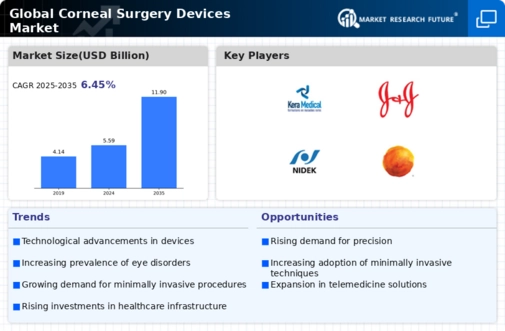Rising Healthcare Expenditure
The Global Corneal Surgery Devices Market Industry is benefiting from increasing healthcare expenditure across various regions. Governments and private sectors are investing more in healthcare infrastructure, which includes the procurement of advanced surgical devices. This trend is particularly evident in developing countries, where improved healthcare access is leading to higher rates of surgical interventions. As healthcare systems evolve, the demand for innovative corneal surgery devices is expected to rise, supporting market growth. The anticipated market value of 5.59 USD Billion in 2024 underscores the potential for expansion driven by enhanced healthcare funding.
Increasing Prevalence of Eye Disorders
The Global Corneal Surgery Devices Market Industry is experiencing growth due to the rising incidence of eye disorders such as keratoconus and cataracts. As populations age, the demand for surgical interventions increases. For instance, the World Health Organization indicates that uncorrected refractive errors affect millions globally, necessitating advanced surgical solutions. This trend is expected to drive the market, with projections suggesting a market value of 5.59 USD Billion in 2024. The increasing awareness and accessibility of corneal surgeries further contribute to this growth, as more patients seek corrective procedures to enhance their quality of life.
Growing Awareness and Patient Education
Awareness regarding eye health and the availability of corneal surgery options is on the rise, significantly impacting the Global Corneal Surgery Devices Market Industry. Educational campaigns by health organizations and medical professionals are informing patients about the benefits of surgical interventions for vision correction. This increased awareness is likely to lead to higher patient turnout for surgeries, thereby driving market growth. As patients become more informed about their options, the demand for corneal surgery devices is expected to increase, contributing to the projected market value of 11.9 USD Billion by 2035.
Expansion of Surgical Centers and Clinics
The proliferation of specialized surgical centers and clinics dedicated to eye care is a notable driver of the Global Corneal Surgery Devices Market Industry. These facilities are equipped with state-of-the-art technology and offer a range of corneal procedures, making them more accessible to patients. The establishment of such centers is particularly beneficial in urban areas where demand for eye surgeries is high. As these facilities continue to expand, they are likely to increase the utilization of corneal surgery devices, further propelling market growth. The anticipated CAGR of 7.13% from 2025 to 2035 reflects this trend.
Technological Advancements in Surgical Devices
Technological innovations play a pivotal role in the expansion of the Global Corneal Surgery Devices Market Industry. The introduction of advanced laser systems and minimally invasive techniques has revolutionized corneal surgeries, improving patient outcomes and reducing recovery times. For example, femtosecond lasers have gained popularity for their precision and safety. These advancements not only enhance surgical efficacy but also attract more patients to seek treatment. As a result, the market is projected to grow significantly, reaching an estimated value of 11.9 USD Billion by 2035, reflecting a compound annual growth rate of 7.13% from 2025 to 2035.














